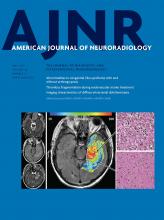Research ArticleAdult Brain
Acute Cytotoxic and Vasogenic Edema after Subarachnoid Hemorrhage: A Quantitative MRI Study
J.M. Weimer, S.E. Jones and J.A. Frontera
American Journal of Neuroradiology May 2017, 38 (5) 928-934; DOI: https://doi.org/10.3174/ajnr.A5181
J.M. Weimer
aFrom the Cerebrovascular Center of the Neurological Institute (J.M.W., J.A.F.)
S.E. Jones
bthe Imaging Institute (S.E.J.), Cleveland Clinic, Cleveland, Ohio.
J.A. Frontera
aFrom the Cerebrovascular Center of the Neurological Institute (J.M.W., J.A.F.)

REFERENCES
- 1.↵
- 2.↵
- Wartenberg KE,
- Schmidt JM,
- Claassen J, et al
- 3.↵
- Grote E,
- Hassler W
- 4.↵
- Sehba FA,
- Bederson JB
- 5.↵
- 6.↵
- 7.↵
- 8.↵
- Frontera JA,
- Ahmed W,
- Zach V, et al
- 9.↵
- Hadeishi H,
- Suzuki A,
- Yasui N, et al
- 10.↵
- 11.↵
- 12.↵
- Hunt WE,
- Hess RM
- 13.↵
- Smith SM
- 14.↵
- Mlynash M,
- Campbell DM,
- Leproust EM, et al
- 15.↵
- Frontera JA,
- Claassen J,
- Schmidt JM, et al
- 16.↵
- Wijman CA,
- Mlynash M,
- Caulfield AF, et al
- 17.↵
- Veelken JA,
- Laing RJC,
- Jakubowski J
- 18.↵
- Bederson JB,
- Germano IM,
- Guarino L
- 19.↵
- Busch E,
- Beaulieu C,
- de Crespigny A, et al
- 20.↵
- 21.↵
- 22.↵
- 23.↵
- 24.↵
- 25.↵
- 26.↵
- Shanmuganathan K,
- Gullapalli RP,
- Mirvis SE, et al
- 27.↵
- Nagesh V,
- Welch KMA,
- Windham JP, et al
- 28.↵
- Schlaug G,
- Siewert B,
- Benfield A, et al
- 29.
- van Swieten JC,
- Koudstaal PJ,
- Visser MC, et al
- 30.
- 31.
- Hijdra A,
- Brouwers PJ,
- Vermeulen M, et al
In this issue
American Journal of Neuroradiology
Vol. 38, Issue 5
1 May 2017
Advertisement
J.M. Weimer, S.E. Jones, J.A. Frontera
Acute Cytotoxic and Vasogenic Edema after Subarachnoid Hemorrhage: A Quantitative MRI Study
American Journal of Neuroradiology May 2017, 38 (5) 928-934; DOI: 10.3174/ajnr.A5181
0 Responses
Jump to section
Related Articles
Cited By...
This article has not yet been cited by articles in journals that are participating in Crossref Cited-by Linking.
More in this TOC Section
Similar Articles
Advertisement











